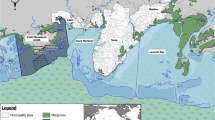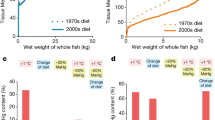Abstract
The Deepwater Horizon oil spill (April 20, 2010) caused concern regarding Gulf seafood safety. Communities were skeptical of governmental risk assessments because they did not take into account the higher consumption of seafood along coastal areas. The objective of this study was to perform a probabilistic risk assessment based on the consumption rates of high-end consumers of Gulf seafood. We utilized seafood consumption data from five communities across the northeastern Gulf of Mexico. This study collected finfish, shrimp, blue crab, and oysters from these communities and analyzed their tissues for polynuclear aromatic hydrocarbons (PAHs). A probabilistic risk assessment was performed using population-specific seafood consumption rates and body weights for commercial fishers, recreational fishers, and a Filipino-American community. For non-cancer effects, 95th percentile hazard quotients for these targeted populations ranged between 1.84E−04 to 5.39E−03 for individual seafood types. The 95th percentile hazard indices for total seafood consumption ranged from 3.45E−03 to 8.41E−03. Based on total seafood consumption, highest hazard indices were modeled for the Filipino-American community followed by commercial and recreational fishers. Despite higher consumption rates, hazard indices for the high-end consumers targeted in this study were two to three orders of magnitude below the regulatory limit of 1.
This is a preview of subscription content, access via your institution
Access options
Subscribe to this journal
Receive 6 print issues and online access
$259.00 per year
only $43.17 per issue
Buy this article
- Purchase on Springer Link
- Instant access to full article PDF
Prices may be subject to local taxes which are calculated during checkout




Similar content being viewed by others
References
McNutt MK, Camilli R, Crone TJ, Guthrie GD, Hsieh PA, Ryerson TB, et al. Review of flow rate estimates of the Deepwater Horizon oil spill. Proc Natl Acad Sci USA. 2012;109:20260–7. https://doi.org/10.1073/pnas.1112139108
U.S. Coast Guard (USCG). On Scene Coordinator Report Deepwater Horizon Oil Spill. Washington, D.C.: United States Coast Guard, U.S. Department of Homeland Security; 2011. https://repository.library.noaa.gov/view/noaa/283. Accessed 1 May 2018.
Greiner AL, Lagasse LP, Neff RA, Love DC, Chase R, Sokol N, et al. Reassuring or risky: the presentation of seafood safety in the aftermath of the British Petroleum Deepwater Horizon oil spill. Am J Public Health. 2013;103:1198–206. https://doi.org/10.2105/AJPH.2012.301093
McKendree MGS, Ortega DL, Widmar NO, Wang HH. 2013. Consumer perceptions of seafood industries in the wake of the deepwater horizon oil spill and fukushima daiichi nuclear disaster. East Lansing: Department of Agricultural, Food, and Resource Economics, Michigan State University; 2013.
Sathiakumar N, Tipre M, Turner-Henson A, Chen L, Leader M, Gohlke J. Post-deepwater horizon blowout seafood consumption patterns and community-specific levels of concern for selected chemicals among children in Mobile County, Alabama. Int J Hyg Environ Health. 2017;220:1–7. https://doi.org/10.1016/j.ijheh.2016.08.003
Simon-Friedt BR, Howard JL, Wilson MJ, Gauthe D, Bogen D, Nguyen D, et al. Louisiana residents' self-reported lack of information following the Deepwater Horizon oil spill: effects on seafood consumption and risk perception. J Environ Manag. 2016;180:526–37. https://doi.org/10.1016/j.jenvman.2016.05.030
Ylitalo GM, Krahn MM, Dickhoff WW, Stein JE, Walker CC, Lassitter CL, et al. Federal seafood safety response to the Deepwater Horizon oil spill. Proc Natl Acad Sci USA. 2012;109:20274–9. https://doi.org/10.1073/pnas.1108886109
U.S. Food and Drug Administration (FDA). Protocol for interpretation and use of sensory testing and analytical chemistry results for re-opening oil-impacted areas closed to seafood harvesting due to the Deepwater Horizon oil spill. U.S. Food and Drug Administration, U.S Department of Health and Human Services, Silver Spring. 2010. https://www.fda.gov/Food/ucm217601.htm. Accessed 1 May 2018.
Florida Department of Health (FDOH). Human health-based screening levels for petroleum products impacting gulf coastal waters and beach sediments. Florida Department of Health, Tallahassee. 2010. http://www.floridahealth.gov/environmental-health/private-well-testing/_documents/Screeninglevels.pdf. Accessed 1 May 2018.
Gohlke JM, Doke D, Tipre M, Leader M, Fitzgerald T. A review of seafood safety after the Deepwater Horizon blowout. Environ Health Perspect. 2011;119:1062–9. https://doi.org/10.1289/ehp.1103507
Rotkin-Ellman M, Wong KK, Solomon GM. Seafood contamination after the bp gulf oil spill and risks to vulnerable populations: a critique of the fda risk assessment. Environ Health Perspect. 2012;120:157–61. https://doi.org/10.1289/ehp.1103695
Wilson M, Frickel S, Nguyen D, Bui T, Echsner S, Simon BR, et al. A targeted health risk assessment following the Deepwater Horizon oil spill: polycyclic aromatic hydrocarbon exposure in Vietnamese-American shrimp consumers. Environ Health Perspect. 2015;123:152–9.
Mahaffey KR, Clickner RP, Jeffries RA. Adult women’s blood mercury concentrations vary regionally in the United States: Association with Patterns of Fish Consumption (NHANES 1999-2004). Environ Health Perspect. 2009;117:47–53.
Dickey R, Huettel M. Seafood and beach safety in the aftermath of the Deepwater Horizon oil spill. Oceanography. 2016;29:196–203. https://doi.org/10.5670/oceanog.2016.83
(U.S. Environmental Protection Agency (USEPA). Guidance for assessing chemical contaminant data for use in fish advisories. Fish Sampling and Analysis (Vol. 1) 3rd ed. Washington, D.C.: Office of Water, U.S. Environmental Protection Agency; 2000.
Harris SA, Urton A, Turf E, Monti MM. Fish and shellfish consumption estimates and perceptions of risk in a cohort of occupational and recreational fishers of the Chesapeake Bay. Environ Res. 2009;109:108–15.
Polissar NL, Neradilek M, Aravkin AY, Danaher P, Kalat J. Draft statistical analysis of National and Washington State Fish Consumption Data. Office of Water, Washington State Department of Ecology, Office of Water; Seattle. 2012.
Sechena R, Liao S, Lorenzana R, Nakano C, Polissar N, Fenske R. Asian American and Pacific Islander seafood consumption: a community-based study in King County, Washington. J Expo Anal Environ Epidemiol. 2003;13:256–66.
Smith S, Jacob S, Jepson M, Israel G. After the Florida net ban: the impacts on commercial fishing families, society and natural resources. Soc Nat Resour. 2003;16:39–59.
Warner K. Mercury Levels in Hair of Coastal Alabama Anglers and Residents. Washington, DC: Oceana; 2007.
Washington State Department of Ecology (WDOE). 2012. Responses to public comments on fish consumption rate issues. Department of Ecology, Washington State Department of Ecology, State of Washington, Olympia. 2012. https://fortress.wa.gov/ecy/publications/documents/1209055.pdf. Accessed 2 May 2018.
Mathews AE, Al-Rajhi A, Kane AS. Validation of a photographic seafood portion guide to assess fish and shrimp intake. J Public Health Nutr. 2018;21:896–901.
Ramalhosa MJ, Paíga P, Morais S, Delerue-Matos C, Pinto Oliveira MBP. Analysis of polycyclic aromatic hydrocarbons in fish: evaluation of a quick, easy, cheap, effective, rugged, and safe extraction method. J Sep Sci. 2009;32:3529–38.
Smith D, Lynam K. Polycyclic aromatic hydrocarbon (PAH) analysis in fish by GC/MS using QuEChERS/dSPE sample preparation and a high efficiency DB-5ms ultra inert GC column. Agilent Technologies, Inc., Wilmington. 2011.
U.S. Environmental Protection Agency (USEPA). Risk Assessment Guidance for Superfund: Volume III—Part A, Process for Conducting Probabilistic Risk Assessment (EPA 540-R-02-002). Washington, D.C.: Office of Emergency and Remedial Response, U.S. Environmental Protection Agency; 2001.
Cullen AC. The sensitivity of probabilistic risk assessment results to alternative model structures: a case study of municipal waste incineration. J Air & Waste Manag Assoc. 1995;45:538–46.
USEPA. Risk Assessment Guidance for Superfund. Human Health Evaluation Manual (Vol. 1, Part A), Interim Final. Office of Emergency and Remedial Response, United States Environmental Protection Agency: Washington, DC; 1989.
Burger J, Campbell K. Fishing and consumption patterns of anglers adjacent to the Oak Ridge Reservation, Tennessee: higher income anglers ate more fish and are more at risk. J Risk Res. 2008;11:335–50.
Burger J, May H. Fishing and consumption patterns of anglers adjacent to the Oak Ridge Reservation, Tennessee: higher income anglers ate more fish and are more at risk. J Risk Res. 2008;11:335–50. https://doi.org/10.1080/13669870701795560
Anderson AC, Rice JC. Survey of fish and shellfish consumption by residents of the greater New Orleans area. Bull Environ Contam Tolxicol. 1993;51:508–14.
Wickliffe, JK, Simon-Friedt, B, Howard, JL, Frahm, E, Meyer, B, Wilson, MJ, et al. Consumption of fish and shrimp from southeast Louisiana poses no unacceptable lifetime cancer risks attributable to high-priority polycyclic aromatic hydrocarbons. Risk Anal. 2018. https://doi.org/10.1111/risa.12985
Center for Environmental & Human Toxicology (CEHT). Final Baseline Risk Analysis for Chapter 62-302, F.A.C. Tallahassee: Florida Department of Environmental Protection; 2008.
Acknowledgements
This publication was made possible by the Deepwater Horizon Research Consortia grant U19 ES020683 (University of Florida) from the National Institute of Environmental health Sciences (NIEHS), National Institutes of Health (NIH), Department of Health and Human Services.
Author information
Authors and Affiliations
Corresponding author
Ethics declarations
Conflict of interest
The authors declare that they have no conflict of interest.
Additional information
Publisher’s note: Springer Nature remains neutral with regard to jurisdictional claims in published maps and institutional affiliations.
Supplementary information
Rights and permissions
About this article
Cite this article
Stuchal, L.D., Charles-Ayinde, M.K.S., Kane, A.S. et al. Probabilistic risk assessment for high-end consumers of seafood on the northeastern Gulf coast. J Expo Sci Environ Epidemiol 30, 478–491 (2020). https://doi.org/10.1038/s41370-019-0119-4
Received:
Revised:
Accepted:
Published:
Issue Date:
DOI: https://doi.org/10.1038/s41370-019-0119-4
Keywords
This article is cited by
-
Exposure Assessment of methyl mercury from consumption of fish and seafood in Peninsular Malaysia
Environmental Science and Pollution Research (2022)
-
Increased long-term health risks attributable to select volatile organic compounds in residential indoor air in southeast Louisiana
Scientific Reports (2020)



